ISSN 2410-5708 / e-ISSN 2313-7215
Year 12 | No. 34 | June - September 2023
© Copyright (2023). National Autonomous University of Nicaragua, Managua.
This document is under a Creative Commons
Attribution-NonCommercial-NoDerivs 4.0 International licence.
Multifunctional furniture design for low-income housing in Autlan, Jalisco, Mexico
https://doi.org/10.5377/rtu.v12i34.16356
Submitted on July 06th, 2022 / Accepted on April 11th, 2023
Manuel Alejandro Reyes Mendoza.
Architect by the Instituto Tecnológico José Mario Molina
Pasquel y Henríquez. El Grullo, Jalisco, Mexico.
Francisco José Martín del Campo Saray
Professor-researcher at the Instituto Tecnológico José Mario
Molina Pasquel y Henríquez. El Grullo, Jalisco, Mexico.
Jonás Michel Horta.
Professor-researcher at the Instituto Tecnológico José Mario
Molina Pasquel y Henríquez. El Grullo, Jalisco, Mexico.
Section: Engineering, Industry and Construction
Scientific research article
Keywords: Accessibility, Multifunctional furniture, Lowincome, housing, Ergonomics, Anthropometry
Abstract
The dimensions and design of low-income housing are deficient in space optimization; and when integrating common furniture, it does not adapt adequately to the areas assigned for its use. The objective of this study was to optimize the furniture for low-income housing in Autlan, Jalisco, Mexico. The research method was descriptive, correlational, propositional, and field research. Three representative neighborhoods of Autlan (Infonavit, Villas Taurinas, and Valle del Vergel) were sampled. These neighborhoods are characterized by small living spaces. A total of 150 questionnaires were completed with responses by category and multiple choice, and variables of the questionnaire used were analyzed and a modular design proposal for the most demanded multifunctional furniture was elaborated, based on the preference of the inhabitants of living spaces. Regarding the reasons for the preference for furniture by the inhabitants of the study area, the most relevant aspect was comfort, followed by spatial function. Concerning the reason for the placement of furniture by the interviewees, the first factor was the adequacy of space, followed by the comfort factor, storage, and finally functionality. This research contributed to the economic-social factor of the population studied.
Introduction
Due to their size and design, low-income housing units are lacking in space optimization, which means that when common furniture is integrated, it does not adapt adequately nor is it functional. They exceed the measurements and in many cases, one or more pieces of furniture must be omitted.
In Autlán, Jalisco, Mexico, 35% of the population lives in small houses, mainly of the social interest type, and they have the basic infrastructure. One of the characteristics of these buildings is their small spaces, which are difficult to furnish, due to the lack of adequate furniture and coupled with the demand for housing due to population growth in the South Coast region of Jalisco.
In this region, there are localities and towns which need to show their inhabitants show labor progress and better quality of life, so they resort to changing their place of residence and settling in this place. It is reflected, that people who live in houses of social interest, generally belong to the middle, lower-middle, and lower class, where their type of employment does not allow them to have an optimal economic and social standard of living. In agreement with Rodríguez-Sánchez (2018), two problems are visualized that go hand in hand, on the one hand, the concern of adequate furniture for small houses, which are massively generated for the working class; and on the other hand, populations with the need to work, who have attractive raw material in abundance, which they have not known how to exploit for their benefit or that of others. It is believed that these two linked sectors can help each other since the rural sector could significantly improve its quality of life if the raw material it has will provide added value to the furniture destined for the urban sector of the working class; likewise, with an adequate design, the cost is reduced and this type of furniture is improved.
For the reasons stated above, it was of utmost importance to know what is the design and use of this type of furniture, in this case; the furniture for social housing, and how the design of multifunctional furniture could be the solution to the spaces that are governed, where the universal anthropometry used in Mexico is maintained and integrates regional materials to generate furniture with identity, thus, contributing to the benefit of the population. Under this perspective, the problem was focused on the city of Autlan, Jalisco, because it is a city of rapid urban growth; and most of the population has been forced to acquire houses of social interest, facing the difficulty of obtaining adequate furniture to their needs of living space.
The choice of the multifunctional furniture design for social housing arose from the growth of this city. It was projected as multifunctional furniture (a piece of furniture that fulfills different functions), to reduce the presence of furniture in social housing, so that it can be adaptable to any type of architectural distribution. Therefore, the design of the furniture is economical, resistant, functional, and easy to assemble. The use of multifunctional furniture emerges as a virtue, where a new decorative ideology is conceived, with a common thought: furniture for minimum habitable spaces, pleasing to the eye, changeable, and comfortable.
Accordingly, it was intended to carry out this research that would be of interest to citizens, with the purpose that the proposed furniture generates greater comfort in living spaces, where efficiency is evident and, therefore, benefit families who have this type of housing.
Theoretical discussion
According to the needs of the study, an analysis of readings of specialized bibliography was carried out under three perspectives; from international to local, from recent to old, and by themes; and they are presented below.
A study consulted points out that, the thermal condition in the rental houses in Merauke, Indonesia, is uncomfortable, one of the causes is that, the existence of household furniture is not organized, which makes the circulation of the space not uniform. In cramped housing conditions, multifunctional furniture is required. This research aimed to design multifunctional furniture that had more than four functions, this study used an experimental method, and the analyzed data included; the spatial amount of rented house, the amount of each room in the rented house, and the amount of furniture, this study focused on the bedroom.(Alahudin et al., 2018).
Another study deals with the development of functional furniture for single-family homes as a product affinity. Going forward, the number of single-family homes has been increasing worldwide, especially in Western Europe, North America, and Northeast Asia. As a result, the size of homes is shrinking, which means that people do not require large furniture. According to previous studies, single-family homes generally have space limits, and members of these households want to use resources efficiently. To this end, companies have marketed furniture and products for small living spaces such as home appliances, transformable furniture, and multifunctional products. (Ahn, 2017).
On the other hand (Bei and Jing, 2013) pointed out the following: with the global industrial restructuring, creative industries have become the new model of China’s economic development. In the economic context of increasing demand for creative products and artwork, customized furniture design has become the focus of China’s creative industries. The creation of customized furniture brought a challenge to the furniture industry. Designers should not only meet the reasonable structure and function of furniture, but they should also meet the basic needs of consumers to the maximum extent.
In terms of household products available in the market, there are many kinds of space-saving furniture such as folding tables and chairs. The sleeper sofa is a piece of furniture that can be used as both a sofa and a bed. This flexibility of convertible sofas into beds has proved to be of great help to those who live in small apartments and find themselves worried about sleeping accommodations for their guests. They can be easily converted into beds at night and once their purpose is served, they can be rearranged back into a sofa. They are not difficult to arrange as they are flexible and comfortable enough to manipulate. (Wang, 2013).
As pointed out by Wang (2013), there are many types of classic space-saving transformable furniture designs from which customers can choose. In general, these include beds, tables, and other space-saving furniture. This type of furniture is useful for use in a bedroom, for example.
Rajan-Palanivel et al. (2019), meanwhile, refer that most of the middle-class Indian population, live in cramped spaces, partly because of their economy and lack of availability of living areas. In this scenario, furniture occupies most of the space inside the house which causes congested spaces. To overcome this problem, furniture must have multiple purposes for its main function. It is mainly about generating a new concept in furniture.
From another perspective, overcrowded space is a contributing factor to social and economic problems in impoverished areas such as the Jabal Al-Natheef refugee camp in Jordan. Addressing a complicated problem requires long-term planning and the availability of resources of all kinds. The project showed the need and capability of multifunctional furniture design features to maximize the use of space and improve the living conditions of people living in segregated communities. A piece of furniture was designed to serve as a tabular unit, storage and seating unit, as well as a sleeping unit depending on need and time of day. To facilitate a local people-driven manufacturing process, furniture design specifications and prototype diagrams were produced. (Nasser, 2013).
Another pointer is from Leon-Moscoso et al. (2019) who state that the versatility of a given piece of furniture should be considered in small interior spaces, as a solution that confines and shapes areas to live and work in the same place.
For his part, Chen (2016) mentions that the starting point is the investigation of a single person’s home. According to a government presentation in Sweden, the family structure has changed as time goes by. By 2056, there will be more than 40% of households that are single-person households. In addition, the project aims to create shared living room furniture for young single households.
In Colombia, particularly in the city of Bogota, although multifunctional furniture is a good option in the face of the problem of precarious space, its costs are high, making it unaffordable for the Colombian population living in low-income housing. Diseño Interior de Mobiliario (DIMO Interior Furniture Design) is a furniture system composed of an extendable sofa and a table of variable shape, this is to offer the user products that adapt to their activities, offering the opportunity to adapt the furniture to the space according to the need of the moment, at an affordable cost. (Youssef-Yusuf and Pardo-Martínez, 2017).
For their part, González-Cabrera and Polifroni-Peñate (2017) emphasize that multifunctionality is a characteristic that aims to fulfill additional functions to those of its main purpose. In the case of furniture, there are diverse ways of applying this characteristic; for chairs in particular, there is a classification of the types of functions that these can fulfill.
In Latin America, it highlights (UN-Habitat, 2017) that multifunctional furniture has begun to be developed, as an example, we can mention the Toco Madera project in 2010, developed in the scope of the research and extension activities of the University School Design Center of Uruguay to provide a domestic equipment solution to social assistance programs or populations in the face of disaster situations. Its main innovations consist of material standardization, production simplicity of the pieces and its joining system provides efficient flexibility.
On the other hand, Tenorio-Tupacyupanqui (2014) refers that the housing deficit suffered by Ecuador and particularly the city of Cuenca has forced institutions such as the municipality to offer low-cost housing, where the size of the rooms is sacrificed by reducing them to the maximum, so it is necessary to propose a new type of furniture that meets the needs of comfort, organization, and functionality. The objective of the project was to design a set of multifunctional furniture applicable to homes that would be feasible and functional for the families that occupy these spaces. Correa-Montes (2010) mentions that the development of a social culture, preferences, and conception of living space, constitute a reality in the decision-making process regarding the acquisition of a personal and private space, which provides satisfaction for the user, since architecture and design trends have emerged, pigeonholing the manufacture of innovative spaces in housing, where the person is the reference point in the development of an innovative design process.
For their part, Calderón-Tenorio and López-Espinoza (s/f) investigated the conditions of Salvadoran housing that have been developed in that decade, where the same model established by their cultural environment is followed. Low cost and reduced space are the main characteristics on which construction policies are based; this is one of the problems faced by Salvadorans when looking for and acquiring a home, thus diminishing people’s quality of life.
In addition to the above, García and Ruiz (2012) state that to make the most of space in a living room, order is essential and shelves allow for creating personalized compositions and making divisions in the room without the help of other elements.
Briceño-Saénz, (2009) refers that the furniture of a living space corresponds to a lifestyle, by which it is differentiated and is often seen in the houses of social interest, where despite being identical models, each house has a different personality which depends on the furniture and the way it is distributed and which also depends directly on the way it is lived inside it.
From another perspective, it is reflected that furniture is one of man’s most precious assets, he sits on it, sleeps on it, eats on it, and perhaps most importantly, puts his most valuable belongings on it (Eckelman, 2003).
Consequently, Cubilla and Yaciel (2020) point out that furniture products should be usable and accessible to the greatest number of people within a population, which should reduce the need for a particular design or special adaptation. On the other hand, Coleman et al. (2003) mention that to create a good design, it is essential to understand the demands and capabilities of the intended users to obtain meaningful results that solve their basic needs.
After presenting the theoretical positions of authors and their interpretations of furniture for living spaces, we continue with the methodological section applied to the research conducted.
Methodology
For research purposes, descriptive, correlational, propositional, and field research method was used. Based on the analyzed bibliography and due to the needs of the study, the use of data collection instruments applied to the inhabitants of low-income housing was implemented to know their preferences and personal expectations about the furniture used.
The research was conducted in the city of Autlán, Jalisco, Mexico, and as a context, it is located southwest of the state, with an altitude of 925 meters above sea level, a semi-dry climate, an average annual temperature is 23.5°C, with a maximum of 30.5 °C and minimum of 9 °C, with an average precipitation of the 997.5 millimeters (Cuaderno Estadístico Municipal IIEG, 2019).
As a study area, three representative colonies of Autlán (Infonavit, Villas Taurinas, and Valle del Vergel) were taken for sampling. These neighborhoods are characterized by having low-income housing and, consequently, small living spaces. See figures 1, 2, and 3.
Figure 1
Aerial view of neighborhood Infonavit.

Source: Adapted from Google Earth, 2020.
Figure 2
Aerial view of neighborhood Valle del Vergel.
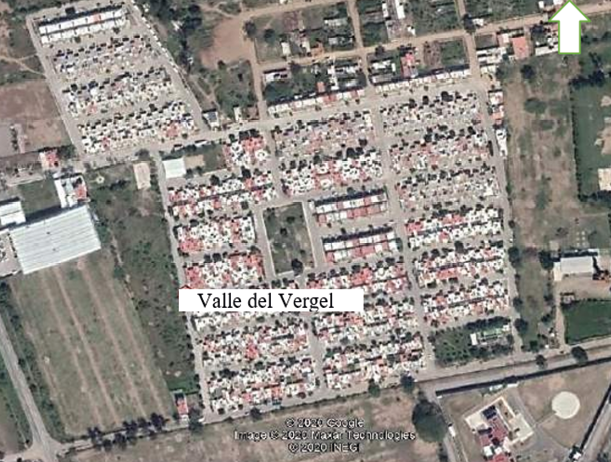
Source: Adapted from Google Earth, 2020.
Figure 3
Aerial view of neighborhood Villas Taurinas.

Source: Adapted from Google Earth, 2020.
For the sampling design, the reference was taken from inhabitants of the Infonavit, Valle del Vergel, and Villas Taurinas neighborhoods who had been living in their neighborhood for a minimum of six months and who were over 12 years of age. A total of 150 questionnaires were completed with responses by category and multiple choice.
As an instrument for data collection, a questionnaire was used with the help of a Likert scale according to the needs of the research, and the questions were structured by sections, to facilitate the filling out and interpretation of the data at the time of emptying the information.
The application of the information and data collection questionnaire took a maximum of 5 minutes. The sampling date for the three neighborhoods was May 23-25, 2020 with a total of 150 questionnaires. For the aforementioned sampling, we had the human support of two people, and the data capture was carried out in the Microsoft Excel Windows program to code variables and establish results through graphs. See figure 4.
Figure 4
Data collection in Colonia Valle del Vergel.

Results
The following is a presentation of the results obtained for the design study of multifunctional furniture for low-income housing in the city of Autlan, Jalisco, Mexico.
As described in the methodology section, the application of the study was carried out in the Infonavit, Valle del Vergel, and Villas Taurinas neighborhoods, based on this, the variables of the questionnaire used were analyzed and we proceeded to elaborate the proposal of multifunctional furniture most demanded by users based on their preference of living spaces.
The results were obtained in the following order of variables:
Age range, sex, time of inhabiting, preferred furniture, the reason for preference, knowledge of multifunctional furniture, furniture placement, the reason for furniture placement, preferred material, and willingness to pay for furniture.
The multifunctional furniture designs, which, according to the responses of the interviewees, were of their preference, were the living room in the first place and the bedroom in the second place. Based on this, some images are shown alluding to the first author’s proposal for furniture design in low-income housing. Figures 5, 6, and 7 show the difference in the functionality of the living room furniture from an initial piece to four different functions, which facilitate the interaction between the users of this architectural space, it also contributes to performing several activities at the same time, such as conversing, drinking, resting and storing objects.
Figure 5
4-in-1 room design.
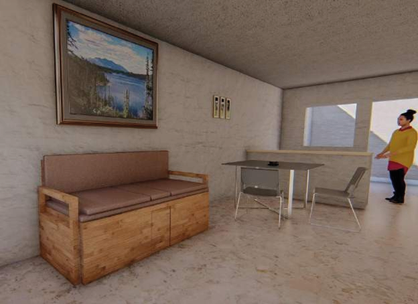
Figure 6
Room design showing furniture alternatives.
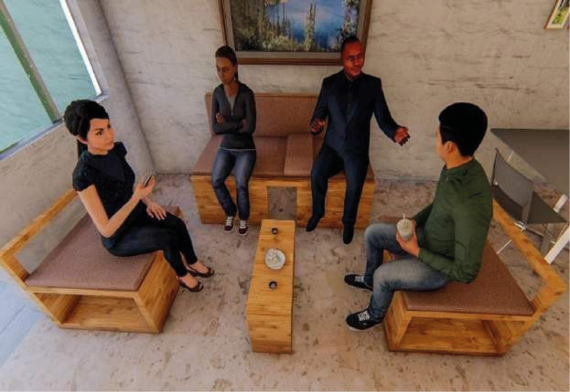
Figure 7
Room design showing furniture alternatives.
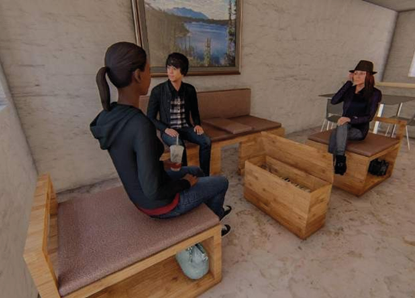
Regarding the bedroom design, we propose a headboard with a sliding compartment and a shelf that serves as a bureau; and in the lateral parts of the base, there are drawers for storing objects. See figures 8 and 9.
Figure 8
Bedroom design showing furniture alternatives.
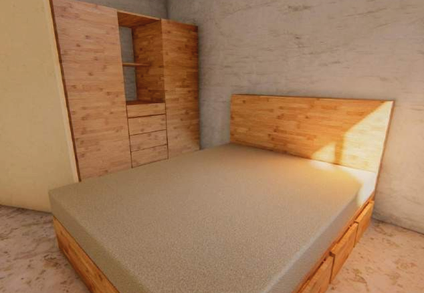
Figure 9
Bedroom design showing the furniture alternatives in the bedroom.
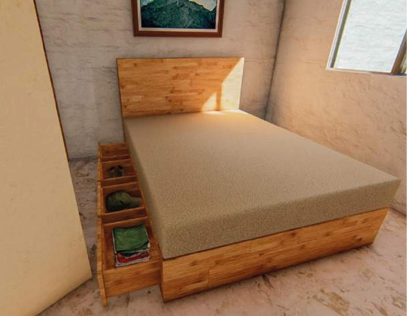
As part of the additional furniture in the bedroom, a closet with four sliding towers is proposed that serves the function of storing and hanging clothes, in the same way; since the furniture is not unfolded, the towers are used to place books, picture frames, and facial mirrors. See figure 10.
Figure 10
Bedroom design showing closet furniture alternatives.
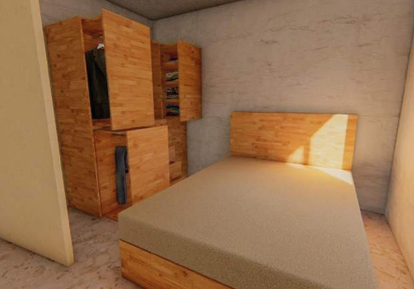
Conclusions
The main objective of this research was to present the results of multifunctional furniture preferences in low-income housing in the city of Autlan, Jalisco, Mexico, with the purpose that this type of study may be of interest and benefit to similar neighborhoods and that this furniture model could be replicated in other municipalities in the region.
Based on the results of the study, it was determined that the use of multifunctional furniture in the reduced spaces represented by low-income housing was fundamental in the responses of preference of the inhabitants of the Infonavit, Valle del Vergel, and Villas Taurinas neighborhoods.
According to the above, in the Infonavit and Valle del Vergel neighborhoods, the preferred architectural space was the living room, as opposed to the Villas Taurinas neighborhood, where the bedroom was the preferred space.
Once this record was obtained, we proceeded to design multifunctional furniture for the living room and bedroom, where we chose to implement a single piece of modular furniture that becomes four pieces in the living room area, on the bedroom we chose a double base with drawers on the sides and headboard with folding devices that function as a side shelf and bureau, in addition, we implemented a closet with sliding towers that store clothes and various objects.
Concerning the reasons for furniture preference by the inhabitants of the study area, the most important aspect mentioned was comfort, followed by spatial function.
Regarding the motive for furniture placement by the interviewees, the first factor was space adequacy, followed by comfort, storage, and finally functionality.
The manufacturing material for furniture preferred by the interviewed population was wood, followed by chipboard and MDF. On the variable of willingness to pay for the manufacture of multifunctional furniture, the price range of 2,000 to 5,000 Mexican pesos was the highest preference of the inhabitants of the sample.
To conclude this section, it is suggested that the study be followed up in future research, to promote better welfare conditions for the inhabitants of low-income housing.
to the inhabitants of low-income housing in terms of the functioning of their furniture to optimize their level of habitability.
Works Cited
Alahudin, M., Nurhusna, A., & Simorangkir, Y. V. (2018, December). The Effect of Using Innovative Furniture on Space Circulation in Lease Houses in Merauke. In International Conference on Science and Technology (ICST 2018) (pp. 968-971). Atlantis Press.
Ahn, Y. (2017). NEST: The development of functional furniture as product convergence.
Bei, F., & Jing, Y. (2013). The Creative Design Research of Personalized Furniture. In Proceedings of 2012 3rd International Asia Conference on Industrial Engineering and Management Innovation (IEMI2012) (pp. 179-192). Springer Berlin Heidelberg.
Briseño Saénz, J. E. (2009). Estudio para el mejoramiento del mobiliario en casas de interés social de la ciudad de San Luis Potosí, SLP. Una alternativa actual para el vínculo entre el medio rural y urbano.
Cabrera, M. A. G., & Peñate, O. P. (2015). Creación de una plataforma interactiva para la comercialización de mobiliario modular personalizado en espacios reducidos. Revista Arte & Diseño, 13(2).
Calderón Tenorio, V. E., & López Espinoza, Z. E. Línea de diseño para la creación de muebles multifuncionales. Proyecto de emprendedurismo.
Chen, D. (2016). Fika Living: A sharing multifunctional furniture for single-person households.
Coleman, R., Keates, S., & Lebbon, C. (2003). Inclusive design: Design for the whole population.
Correa Montes, M. A. (2010). Mobiliario multifuncional compacto para nuevas viviendas colombianas.
Cuaderno Estadístico Municipal IEEG. (2019). https://iieg.gob.mx/contenido/Municipios/Autlan19.pdf
Cubilla, A., & Yaciel, S. (2020). Nivel de conocimiento de la accesibilidad arquitectónica y urbanística para las personas con discapacidad en el corregimiento de Santiago, 2020.
Eckelman, C. A. (2003). Textbook of product engineering and strength design of furniture. Purdue University, West Lafayette, Indiana, 65-67.
García, M., & Ruiz, D. (2012). El cuerpo y los gestos en la escuela. Talleres, 13, 45-48.
HÁBITAT, O. Los Objetivos de Desarrollo Sostenible y la Iniciativa de Ciudades Prósperas.» ONU HÁBITAT. 2017.
León Moscoso, V. (2019). Habitar y trabajar en un mismo espacio usando un mobiliario multifuncional (Bachelor’s thesis).
Nasser, F. (2013). Multifunctional furniture for underprivileged communities: A milestone in sustainable development (Doctoral dissertation, Purdue University).
Rajan, A. P., Elavarasan, D., Balaji, S., Dinesh, A., & Gowtham, K. (2019). Design and fabrication of multifunctional furniture. Int. J. Res. Eng. Sci. Manag, 2, 442-447.
Rodríguez Sánchez, S. A., y Gómez Janer, D. A. (2018). Plan de negocios enfocado a venta mobiliario multifuncional para áreas residenciales reducida.
Tenorio Tupacyupanqui, M. V. (2014). Diseño de mobiliario multifuncional para el programa de viviendas del EMUVI (Bachelor’s thesis, Universidad del Azuay).
Youssef Yusuf, O., & Pardo Martínez, E. DIMO: mobiliario modular para viviendas de interés social prioritario.
Wang, S. (2013). An analysis of transformable space-saving furniture.
Figures source
Figures 4 a 10: Authors, 2020.
Figures 1, 2 y 3: Adapted from Google Earth, 2020 (https://earth.google.com/web/search/ Autl%c3%a1n+de+Navarro,+Jal./@19. 76808732,104.36536513,926. 22429381a,17489.68890738d,35y,0. 00155802h,0t,0r/data=CoIBGlgSUgolMHg 4NDI0NTVjZTNkMWI3MzR kOjB4MzRiNDYyNTExNTBjNjIxZhk 7F0Z 6UcUzQCFjI7X1eBdawCo XQXV0bMOhbi BkZSBOYXZhcnJvLCBKYWwYAiABIi YKJAn7 DIiDh8MzQBHZN_IiXMAz QBl-JVcwVhZawCEV8j4 -IBhawA)
